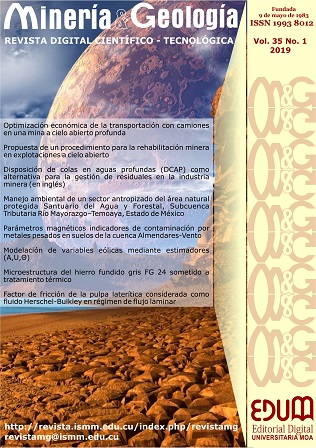The deep sea tailings placement (DSTP) as alternative for the residuals management in the mining industry
Keywords:
mining waste, sustainable mining, tailings deposition, sea mining, marine contamination.Abstract
The article aims to clarify how the deep sea tailings depositions have been used worldwide as alternative mining practice. The paper is a checking of case studies where this technology is used. The available information sources were consulted, which included: case reports, scientific papers, theses and reports by proper authorities. It is achieved to expose the fundamental principles of operation and environmental impact of this technology in the marine environment by applying empirical methods and theoretical research, as well as an assessment of main cases in the world.Downloads
References
Asmund, G.; Broman, P. and Lindgren, G. 1994: Managing the environment at the Black Angel mine, Greenland. International Journal of Surface Mining, Reclamation and Environment, 8(1): 37-40.
Dold, B. 2014: Submarine Tailings Disposal (STD) —A Review. Minerals, 4(3): 642-666.
Elberling, B.; Asmund, G.; Kunzendorf, H. and Krogstad, E. 2002: Geochemical trends in metal-contaminated fiord sediments near a former lead-zinc mine in West Greenland. Applied Geochemistry, 17(4): 493-502.
Ellis, D. 1994: Screening Criteria for Submarine Tailings Disposal, Victoria. Canada: British Columbia.
Ellis, D. and Ellis, K. 1994: Very deep STD. Marine Pollution Bulletin, 28(8): 472-476.
Ellis, D. 2006: A short history of submarine tailings placement (STP) in the context of lessons learned for subsequent sustainable development at a mining site (Update #8). Manuscript Report: 42.
European Integrated Pollution Prevention and Control Bureau. Consulta: 15 ene 2015. Disponible en: http://www.eippcb.jrc.ec.europa.eu
Gaceta Oficial de la República de Cuba. 1995: Ley No. 76 de Minas. La Habana.
Joint Group Of Expert On The Scientific Aspects Of Marine Environmental Pollutions (GESAMP). 2016: In: GESAMP International Workshop on the Impacts of Mine Tailings in the Marine Environment. Rep. Stud. GESAMP No. 94, 84 p.
Hofer, T. 2008: Marine Pollution: New Research. New York: Nova Science Publishers, Inc. 451 p.
Hughes, D.; Shimmield, T.; Black, K. and Howe, J. 2015: Ecological impacts of large-scale disposal of mining waste in the deep sea. Scientific Reports, 5: 1-11.
International Maritime Organization (IMO). 2013: International Assessment of Marine and Riverine Disposal of Mine Tailings. In: 34th Meeting of the London Convention and the 7th Meeting of the London Protocol. London, UK (Vol. 1).
Koski, R. A. 2012: Metal dispersion resulting from mining activities in coastal environments: A pathways approach. Oceanography, 25(2): 170–183.
Lottermoser, B. 2007: Mine Wastes: Characterization, Treatment and Environmental Impacts. 3 ed. Berlin Heidelberg: Springer Verlag. 410 p.
May, J. 2014: Mitigation of Environmental Impacts by implementing Deep Sea Tailings Placement – a Case Study of the Moa Mining District in Cuba. Hans-Juergen Gursky (Tutor). Bachelor Thesis. Institute of Geology and Paleontology. TU Clausthal. 63 p.
Moorhead, C. 2013: Technical Report on the Lihir Property in Papa New Guinea, Newcrest Mining. Consulta: 1 feb 2015. Disponible en: http://www.newcrest.com.au/media/resource_reserves/Technical%20Reports/Technical_Report_on_the_Lihir_Property_December_31_2013-Final.pdf
Moran, R. 2008: Riverine and sub-sea disposal of tailings and associated wastes from mining operations around the world: the need for detailed assessment and effective control. Scientific Group of the London Convention. Consulta: 20 feb 2015. Disponible en: http://www.sjofartsverket.se/pages/15453/31-INF14.pdf
Poling, G. and Ellis, D. 1995: Importance of geochemistry: the Black Angel lead-zinc mine, Greenland. Marine Georesources & Geotechnology, 13(1-2): 101-118.
Poling, G.; Ellis, D.; Murray, J.; Parson, T. and Pelletier, C. 2002: Underwater Tailing Placement at Island Copper Mine – A success story. Society for Mining, Metallurgy and Exploration, Littleton, Colorado, USA. 250 p.
Servicio de Información Mundial sobre Energía. Consulta: 3 ene 2015. Disponible en: http://www.wise-uranium.org
Shimmield, T.; Black, K.; Howe, J.; Hughes, D. and Sherwin, T. 2010: SAMS, Final Report, Independent Evaluation of Deep-Sea Mine Tailings Placement (DSTP) in PNG. Oban, UK.
Singhal, R. K. 2009: Mining and the Environment: From Ore to Metal. International Journal of Mining, Reclamation and Environment, 23(4): 241.
Skei, J. 2006: The dilemma of waste management in the mining industry – criteria for sea disposal. Mineralproduksjon, 3 B1-B4, Løvenstad, Norway.
Vogt, C. 2012: International assessment of marine and riverine disposal of mine tailings. In: 34th Meeting of the London Convention and the 7th Meeting of the London Protocol, London, UK (Vol. 1). Consulta: 15 dic 2014. Disponible en: http://www.craigvogt.com/links/Mine_Tailings_Marine_and_Riverine_Disposal.pdf
Published
How to Cite
Issue
Section
Copyright (c) 2019 Yosbanis Manuel Cervantes-Guerra, Allan Pierra-Conde, Jacob Mai, Hans Jürgen-Gursky, Jo Van-Caneghem, Carlo Vandecasteele

This work is licensed under a Creative Commons Attribution-NonCommercial 4.0 International License.
- Authors retain copyright and guaranteeing the right magazine to be the first publication of the work as licensed under a Creative Commons Attribution-NonCommercial that allows others to share the work with an acknowledgment of the work's authorship and initial publication in this journal.
- Authors may establish separate supplemental agreements for the exclusive distribution version of the work published in the journal (eg, place it in an institutional repository or publish it in a book), with an acknowledgment of its initial publication in this journal.
- Authors are allowed and recommended to disseminate their work through the Internet (e.g., in institutional telematic archives or on their websites) before and during the submission process, which can produce interesting exchanges and increase citations of the published work. (See The effect of open access)










